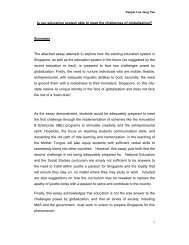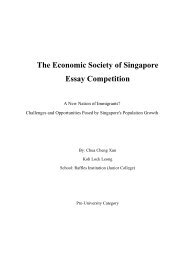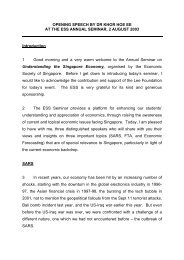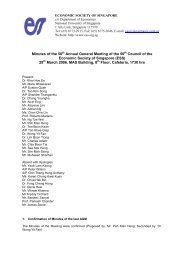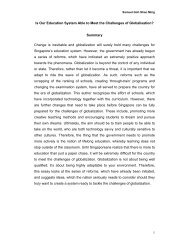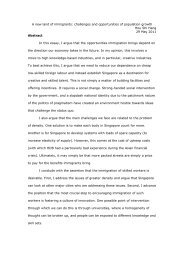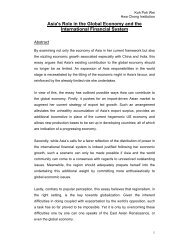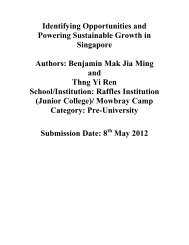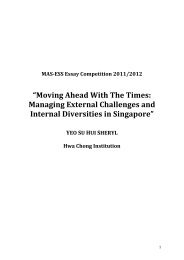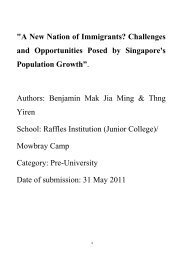here - Economic Society of Singapore
here - Economic Society of Singapore
here - Economic Society of Singapore
- No tags were found...
Create successful ePaper yourself
Turn your PDF publications into a flip-book with our unique Google optimized e-Paper software.
Monetary Policy in <strong>Singapore</strong>Objectives, Framework and RationalePresented byDr Choy Keen Meng, Principal Economist<strong>Economic</strong> Policy Group, MASat the Annual JC Seminar 2013
Outline <strong>of</strong> PresentationThe Objective <strong>of</strong> Price StabilityDefinition and ImportanceThe Exchange Rate as the Instrument for Monetary PolicyWhy the Exchange Rate?The “BBC” SystemFeatures <strong>of</strong> the Band, Basket and CrawlRecent <strong>Economic</strong> Developments and Current IssuesGrowth, Inflation and <strong>Economic</strong> Restructuring
Medium-Term Price Stability“The principle object <strong>of</strong> the Authority shall be ... to maintain price stabilityconducive to sustainable growth <strong>of</strong> the economy” – MAS ActUltimate Objective:Price Stability as the Basis for Sustained <strong>Economic</strong> GrowthIntermediate Target <strong>of</strong> Monetary Policy:Interest Rate/Exchange Rate“For all practical purposes, price stability means that expected changes in theaverage price level are small and gradual enough that they do not materiallyinfluence the economic decisions <strong>of</strong> businesses and households.”- Alan Greenspan, Former Chairman <strong>of</strong> the US Federal Reserve
Importance <strong>of</strong> Price StabilityLow and Stable InflationEliminatesuncertainty frominterpreting pricesignalsLower incidence<strong>of</strong> unpr<strong>of</strong>itableborrowing andlending decisionsEfficientAllocation <strong>of</strong><strong>Economic</strong>ResourcesEncouragesSaving andInvestmentLess uncertaintyover returns onlong-terminvestmentLower riskpremium andreducedborrowing cost<strong>Economic</strong> Growth
Outline <strong>of</strong> PresentationThe Objective <strong>of</strong> Price StabilityDefinition and ImportanceThe Exchange Rate as the Instrument for Monetary PolicyWhy the Exchange Rate?The “BBC” SystemFeatures <strong>of</strong> the Band, Basket and CrawlRecent <strong>Economic</strong> Developments and Current IssuesGrowth, Inflation and <strong>Economic</strong> Restructuring
The Open Economy “Trilemma”“The point is that you can't have it all: A country must pick two out<strong>of</strong> three. It can fix its exchange rate without emasculating itscentral bank, but only by maintaining controls on capital flows (likeChina today); it can leave capital movement free but retainmonetary autonomy, but only by letting the exchange rate fluctuate(like Britain-or Canada); or it can choose to leave capital free andstabilize the currency, but only by abandoning any ability to adjustinterest rates to fight inflation or recession (like Argentina today).”Open Capital AccountTheorem <strong>of</strong> theImpossibleTrinity“ManagedFloat”Exchange RateStabilityControl OverInterest Rate
Why is the exchange rate the idealmonetary policy instrument In<strong>Singapore</strong>?The exchange rate is the idealmonetary policy instrument in<strong>Singapore</strong> because:• It is relatively controllableby the MASSmallEconomywith NoNaturalResources• It has a strong and stablerelationship with domesticinflation• It is suited to <strong>Singapore</strong>’seconomic circumstancesHigh Degree<strong>of</strong> Opennessto TradeHigh Degree<strong>of</strong>Opennessto CapitalFlows
% <strong>of</strong> GDP<strong>Singapore</strong> is highly trade-dependentand completely open to capitalflowsS$ BillionTrade-to-GDP RatioAssets in Banking Sector2102500190Exports200017015015001301109070Imports1000500AsianDollarMarket5065 73 81 89 97 050Domestic70 77 84 91 98 05 2011Q3
Exchange rate policy affectsinflation through two channelsForeign prices <strong>of</strong> importedconsumer goodsCost pressures due to demandfor <strong>Singapore</strong>’s exportsS$NEER translatesforeign price <strong>of</strong>imports into S$.A stronger S$NEERlowers import prices.S$NEER affects exportdemand, t<strong>here</strong>byinfluencing demand for(and prices <strong>of</strong>) factorinputs.Imported foreigninflation channel(Direct channel)Derived demandchannel(Indirect channel)CPI Inflation
YOY % Growth<strong>Singapore</strong>’s inflation rate has beenlower and more stable than theOECDStandard Deviation <strong>of</strong> Inflation (%)25CPI Inflation9Volatility <strong>of</strong> CPI Inflation20<strong>Singapore</strong>87OECD<strong>Singapore</strong>1561050OECD54321-51971 1981 1991 2001201001971-1980 1981-2010
Outline <strong>of</strong> PresentationThe Objective <strong>of</strong> Price StabilityDefinition and ImportanceThe Exchange Rate as the Instrument for Monetary PolicyWhy the Exchange Rate?The “BBC” SystemFeatures <strong>of</strong> the Band, Basket and CrawlRecent <strong>Economic</strong> Developments and Current IssuesGrowth, Inflation and <strong>Economic</strong> Restructuring
Characteristics <strong>of</strong> <strong>Singapore</strong>’sExchange Rate SystemBASKETThe exchange rate is managed against a tradeweightedbasket <strong>of</strong> currencies <strong>of</strong> our majortrading partners and competitorsMitigates volatility <strong>of</strong> international foreignexchange marketsBANDThe trade-weighted S$ is allowed to float withinan undisclosed policy bandAbsorbs short-term market volatility, providesflexibility in managing the exchange rateCRAWLThe policy band itself is adjustable and allowedto “crawl”, reflecting underlying fundamentalsPrevents misalignment in the currency
S$NEER IndexMAS buys and sells S$ againstforeign currencies to keep theS$NEER within the policy bandS$ appreciationWhen the $NEER rises above theupper bound <strong>of</strong> the band, MASintervenes by selling S$.When the $NEER falls below thelower bound <strong>of</strong> the band, MASintervenes by buying S$.Time
S$NEER IndexPolicy Lever (1):Slope <strong>of</strong> policy bandIncrease the pace <strong>of</strong> appreciationS$ appreciationNormally undertaken whenMAS assesses that the trajectory foreconomic activity in the mediumterm is on an upward path.Date
S$NEER IndexPolicy Lever (2):Width <strong>of</strong> policy bandWiden policy band in view <strong>of</strong> volatility across int’l financial marketsS$ appreciationNormally undertaken whendevelopments cause a short-termincrease in S$NEER volatilityDate
S$NEER IndexPolicy Lever (3):Level <strong>of</strong> policy bandRe-centre policy band at current level <strong>of</strong> S$NEERS$ appreciationNormally undertaken whendevelopments cause an abruptshift in the path<strong>of</strong> economic activityDate
Outline <strong>of</strong> PresentationThe Objective <strong>of</strong> Price StabilityDefinition and ImportanceThe Exchange Rate as the Instrument for Monetary PolicyWhy the Exchange Rate?The “BBC” SystemFeatures <strong>of</strong> the Band, Basket and CrawlRecent <strong>Economic</strong> Developments and Current IssuesGrowth, Inflation and <strong>Economic</strong> Restructuring
The monetary policy decision involves anassessment <strong>of</strong> the balance <strong>of</strong> risks togrowth and inflationCPIInflation<strong>Singapore</strong>EconomyGDPGrowthBalance <strong>of</strong> RisksOptimal Policy Path
YOY% GrowthUncertainties remain in the globaleconomy although tail risks have recededConsensus GDP Forecasts76543210-11.82011 2012 20135.9 5.75.12.21.81.5-0.5-0.3US Eurozone Asia ex-JapanModest growth in the US• <strong>Economic</strong> data indicatemodest recovery• Housing picking up• Lingering fiscal concernsRecession in the Eurozone• <strong>Economic</strong> indicatorspoint to continuedcontraction• Financial situation stillfragileResilient growth in Asia• China driving recoveryin intra-regional trade• Strong domesticdemand in ASEAN
Index (Q1 2010 = 100), SAThe <strong>Singapore</strong> economy is expected toexpand by 1–3% this yearStylised GDP Pr<strong>of</strong>ile113Forecast111110109108106• External demandlikely to remainweak, thoughcyclical headwindsmay subside• Domestically,supply-sideconstraints will limitgrowth upside1052011 Q2 Q3 Q4 2012 Q2 Q3 Q4 2013 Q2 Q3 Q4
% YOYMore recently, inflation has risen aboveits historical average% Point Contribution86CPI and MAS Core InflationCPI-All ItemsInflation86Contributions to YOY InflationCarsAccommodationServicesFoodOthersOil-related4MAS CoreInflation4202002-11 Average CPI-All Items Inflation20-22007 2008 2009 2010 2011 2012 2013Jan-Feb-22001-09 2011 20122013Jan-Feb
Index (4-8 Apr 2011 Average=100)108MAS maintained its monetary policy stance inOctober 2012 <strong>of</strong> a modest and gradualappreciation <strong>of</strong> the S$NEERS$ Nominal Effective Exchange Rate (S$NEER)106Appreciation104102100989694DepreciationApr Jul Oct Jan Apr Jul Oct2011 2012
What are the sources <strong>of</strong> inflationarypressures?Sources <strong>of</strong> inflationary pressuresDemand-side pressuresSupply-side pressuresFirm regional demand for<strong>Singapore</strong>’s servicesResource constraints inlabour and housingRobust domestic labourmarket supportingconsumptionStructural change in the<strong>Singapore</strong> economy toproductivity-led growthSustained low globalinterest rates and capitalinflowsAssetpricesTemporary shortages inhousing
The Role <strong>of</strong> Monetary Policy in<strong>Economic</strong> Restructuring1. Monetary policy stance carefully calibrated to take into account the multipleinfluences.• Demand: Act decisively to moderate effects <strong>of</strong> strong demand.• Supply: Temper, but not fully <strong>of</strong>fset cost pressures from permanent supplyshifts. These cost increases are part <strong>of</strong> the market’s process <strong>of</strong> guiding theeconomy to a more sustainable growth path.2. Monetary policy not used to directly target asset prices.• The global experience suggests that macro policy instruments havesignificant effect on the broader economy.• Instead macro-prudential tools and other administrative measures targetedat specific asset markets (e.g. property) are preferred.• However, MAS closely monitors asset prices for “second-round” effects onconsumer prices.3. A holistic, across-government approach to dealing with inflation is required.
Thank You



